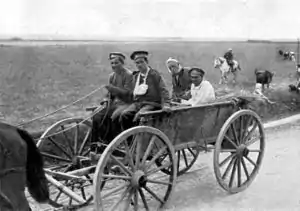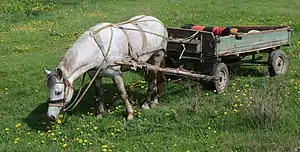
Wounded Russian soldiers in a telega (World War I)

Telega (modern variant). Used in Ukraine in 2017
Telega (Russian: теле́га, IPA: [tʲɪˈlʲɛgə]) is a type of four-wheel horse-drawn vehicle, whose primary purpose is to carry loads, similar to a wain, known in Russia and other countries.[1][2] It has been defined as "a special type commonly used in the southern and south-western provinces for the carriage of grain, hay and other agricultural products".[3]
It is described and spelled telga in Jules Verne's novel Michael Strogoff.
See also
References
Wikimedia Commons has media related to Telega.
- ↑ Телега in the Great Soviet Encyclopedia, 1969–1978 (in Russian)
- ↑ Smith, D.J.M. (1988). A Dictionary of Horse Drawn Vehicles. J. A. Allen & Co. Ltd. p. 160. ISBN 0851314686. OL 11597864M.
Telega. Russian passenger or stage coach. Crudely made and frequently unsprung or dead axle. A larger version of the Tarantass.
- ↑ "Telega carriage", an article from the Brockhaus and Efron Encyclopedic Dictionary (1890-1906)
This article is issued from Wikipedia. The text is licensed under Creative Commons - Attribution - Sharealike. Additional terms may apply for the media files.